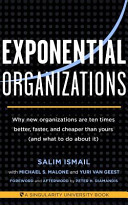

The central premise of 'Exponential Organizations' is the Exponential Organization (ExO) model, which is characterized by its ability to achieve disproportionate impact compared to its peers. ExOs leverage modern technologies and innovative organizational structures to scale rapidly and drive significant growth. Unlike traditional organizations that often grow linearly, ExOs can scale exponentially by utilizing a combination of external resources, advanced technologies, and agile methodologies. The book outlines how these organizations are not just tech companies, but include a wide range of industries and sectors. They are defined by their ability to adapt quickly to changing market conditions and consumer demands, which is crucial in today’s fast-paced environment. The authors present various case studies of successful ExOs, such as Airbnb, Uber, and Google, illustrating how these companies have disrupted traditional markets and created new value propositions. The ExO model encourages organizations to rethink their operational strategies, embrace innovation, and foster a culture of continuous improvement.
Continue readingThe authors introduce the Six D's framework that outlines the stages of exponential growth: Digitization, Deception, Disruption, Demonetization, Dematerialization, and Democratization. Each stage represents a phase in the lifecycle of an innovation or technology. Digitization involves converting analog information into digital formats, which sets the foundation for exponential growth. Deception refers to the initial phase where the growth of the technology is underestimated, leading to skepticism about its potential. Disruption occurs when the technology begins to challenge existing markets and business models. Demonetization is the process of making products or services cheaper, often leading to free alternatives. Dematerialization involves reducing the physical components of a product, making it more efficient and accessible. Finally, Democratization makes the product or service available to a broader audience, thus enhancing its impact. Understanding the Six D's helps organizations anticipate changes in their industry and adapt their strategies accordingly.
Continue readingExponential Organizations possess unique attributes that differentiate them from traditional organizations. The authors identify several key attributes, including a Massive Transformative Purpose (MTP), which serves as the organization's guiding star and motivates employees and stakeholders. ExOs also leverage external resources through crowdsourcing, open innovation, and partnerships, allowing them to scale rapidly without the burden of traditional resource constraints. They utilize data-driven decision-making and advanced analytics to optimize operations and enhance customer experiences. Additionally, ExOs often employ agile methodologies, enabling them to respond quickly to market changes and customer feedback. This combination of attributes allows ExOs to innovate continuously and maintain a competitive edge in their respective industries.
Continue readingA Massive Transformative Purpose (MTP) is a key driver of success for Exponential Organizations. It encapsulates the organization's mission and vision, providing a clear direction and inspiring employees to contribute to a larger goal. The authors argue that an MTP is essential for attracting top talent, fostering a strong company culture, and building customer loyalty. By aligning the organization's objectives with a meaningful purpose, ExOs can create a sense of belonging and commitment among their workforce. The book provides examples of organizations with compelling MTPs, illustrating how these purposes can motivate teams to achieve extraordinary results and drive innovation. An effective MTP not only guides strategic decision-making but also helps organizations navigate challenges and seize opportunities in a rapidly evolving landscape.
Continue readingExponential Organizations harness the power of technology and data to drive growth and innovation. The authors emphasize the importance of adopting emerging technologies such as artificial intelligence, machine learning, blockchain, and the Internet of Things (IoT). These technologies enable ExOs to automate processes, enhance customer experiences, and gather valuable insights from data analytics. By leveraging data, organizations can make informed decisions, identify trends, and personalize offerings to meet customer needs. The book also discusses the role of platforms in facilitating collaboration and resource sharing, allowing ExOs to tap into external expertise and capabilities. The integration of technology and data is crucial for organizations aiming to achieve exponential growth and remain competitive in the digital age.
Continue readingCommunity and collaboration play a significant role in the success of Exponential Organizations. The authors highlight the importance of building a strong community around the organization, which can include customers, partners, and other stakeholders. By fostering collaboration and engagement, ExOs can harness collective intelligence and creativity to drive innovation. The book discusses various approaches to building community, such as open-source initiatives, co-creation, and participatory design. These strategies enable organizations to tap into diverse perspectives and expertise, leading to better products and services. Furthermore, collaboration can enhance customer loyalty and advocacy, as individuals feel a sense of ownership and connection to the organization. The authors argue that cultivating a collaborative culture is essential for organizations seeking to thrive in an interconnected world.
Continue readingThe book explores the implications of the ExO model on the future of work and organizational structures. Traditional hierarchies are being replaced by more flexible, networked structures that prioritize agility and responsiveness. The authors argue that organizations must embrace new ways of working, such as remote collaboration, decentralized decision-making, and cross-functional teams. These changes are driven by advancements in technology and the evolving expectations of the workforce, particularly among younger generations. The book emphasizes the need for organizations to create environments that foster creativity, innovation, and employee empowerment. By adopting new organizational structures and work practices, companies can better adapt to the challenges of the digital age and position themselves for long-term success.
Continue reading